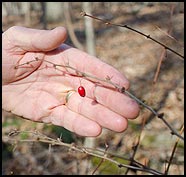HEALTH & NUTRITION...

Scientists Move Closer to Solving Pasture Bloat Problem
Livestock love alfalfa. Alfalfa doesn't always love them back.
As a crop, alfalfa is worth about $8 billion each year to the United States economy because of its role in the domestic beef cattle and dairy industries, as well as exports. Agricultural producers value the legume because it can grow without nitrogen fertilizer by virtue of a symbiosis it forms with bacteria called rhizobia. The bacteria convert atmospheric nitrogen (N2) to ammonia (NH3) that is used for plant growth.
There's just one problem: Livestock that graze extensively on alfalfa often develop pasture bloat, a form of severe indigestion where gas collects in the rumen and cannot be expelled. Extreme bloat can kill an animal. Less severe bloat can still reduce weight gains, lower milk production, reduce feed efficiency and increase labor costs. Read more.
 Animal Care Science Presentations
Animal Care Science Presentations
Tail docking, pain assessment, pharmacological and industry tools discussed in Nashville.
Animal welfare research was presented regarding tail docking, pain assessment and pharmacological tools to the Cattle Health and Well-being Committee at the 2012 Cattle Industry Convention and NCBA Trade Show in Nashville, Tenn.
Dan Grooms, from the Michigan State University College of Veterinary Medicine, shared research evaluating whether there were any performance benefits to tail docking cattle housed on slatted floors. Grant Dewell, beef extension veterinarian at Iowa State University, presented research on pain assessment and management, particularly in dehorning and castration. Dan Thomson of Kansas State University said that the industry can't sit around and wait for legislation to be made, encouraging the industry to develop its own standards for animal welfare. Read more.
 Controlling Japanese Barberry Helps Stop Spread of Tick-Borne Diseases
Controlling Japanese Barberry Helps Stop Spread of Tick-Borne Diseases
A nature-themed drama is unfolding in a corner of the University of Connecticut (UConn) Forest in Storrs, Conn. The story contains elements of surprise, as well as a glimpse of the region's agrarian past.
The protagonist in the drama is the invasive Japanese Barberry (Berberis thunbergii), and Tom Worthley, assistant extension professor in the Department of Extension in the College of Agriculture and Natural Resources, provides a couple of interesting twists in the plot as he explains why eliminating the pest will also help control the spread of the tick-borne diseases of Lyme, granulocytic anaplasmosis, and babesiosis. Read more.

Rick Rasby
Ridin’ Herd
Summer pasture is tight.
I'm a firm believer that cows and pasture go together. There's not a neater picture than a cow in belly-deep grass with her calf at her side. One of the unique characteristics of cattle is they have the ability to convert forage to protein. Budgets for the cow-calf enterprise indicate spring and summer pasture — once considered the most inexpensive time to feed a cow herd — has become a more and more expensive feed resource. This year, it seems pasture is hard to find. This may be due to the drought that occurred last year in states that are considered "big" cow states. What are some of the alternatives for producers to consider as land and pasture costs continue to rise? Read more.
Rapid Detection
Tennessee researchers invent device to rapidly detect infectious disease.
Infectious diseases can spread very rapidly, so quickly identifying them can be crucial to stopping an epidemic. However, current testing for such diseases can take hours and days.
Jayne Wu, associate professor of computer science and electrical engineering at the University of Tennessee (UT), Knoxville, and Shigetoshi Eda, associate professor of forestry, wildlife and fisheries at the UT Institute of Agriculture Center for Wildlife Health, have developed a portable device that can be used onsite to detect infectious diseases, pathogens and physiological conditions in people and animals.
"Time is of the essence in treating infectious diseases," said Wu. "This device has the potential to save a lot of lives by saving time in detection. It also saves a lot of money, as it is cheaper to detect diseases than the system that is currently being used since we do not have to send them to a lab and have the sample be scrutinized by technicians."
Read more.
Prevent Scours in Young Calves
George Barrington of Washington State University says two major strategies for disease prevention are to:
- 1. Reduce introduction of infectious disease agents into the herd (external biosecurity), and
- 2. Reduce transmission of disease that is already present (internal biosecurity).
Measuring Feed Efficiency on Grass
Noble Foundation, Growsafe collobrate to better understand feed efficiency in pasture-fed beef cattle.
The Samuel Roberts Noble Foundation and GrowSafe Systems Ltd. are collaborating to test and leverage GrowSafe's latest technology to better understand feed efficiency in pasture-fed beef cattle and develop tools for sustainably improving production of grazing livestock.As the population increases, "so does the demand for protein-rich beef," said Billy Cook, director of the Noble Foundation's Agricultural Division. "As efficient as cattlemen in the United States have been during the past 30 years, we want to continue and even improve on these efficient practices. We want to provide them new tools to better utilize the resources they have, and we will do it for grazing animals — an area overlooked in the field of feed efficiency improvement." Read more.
Cattle Diseases: Common Conditions/Terms
Click here for a list of common conditions and terms related to beef cattle diseases, such as anaplasmosis, brucellosis, BVD, E. coli, IBR and others.
[Click here to go to the top of the page.]











